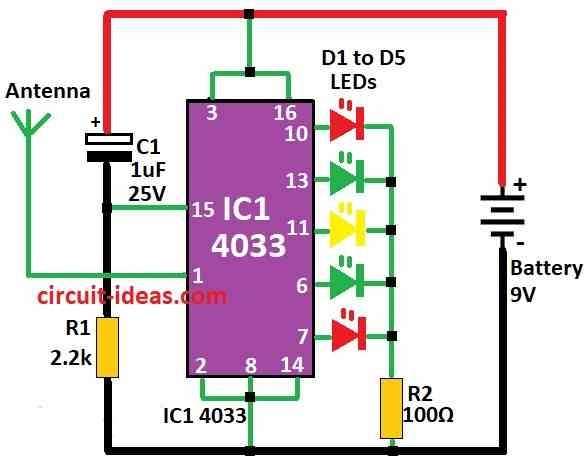Simple Radiation Sensor Circuit is like small spy for rays which one cannot see.
It can smell different radiation like from light bulb, electromagnetic, or X-ray (ionizing one) etc.
This circuit have special sensor when radiation detects sensor feels it and send signal.
The circuit then uses that signal to modify things such as showing a number on the screen or even making the light brighter as more radiation comes in.
People use this circuit in many things like smoke alarm, doctor machine and more.
Circuit Working:

Parts List:
| Category | Component | Quantity |
|---|---|---|
| Resistors | 2.2k 1/4 watt | 1 |
| 100Ω 1/4 watt | 1 | |
| Capacitors | Electrolytic 1µF 25V | 1 |
| Semiconductors | IC 4033 | 1 |
| 5mm 20mA | 5 | |
| Antenna | 1 | |
| Battery 9V | 1 |
This is simple tool for checking how much radiation come from electric or electronic thing.
When device make electromagnetic radiation the LEDs in circuit start running light pattern.
It can catch radiation from computer or TV or even from 2 feet far or more.
If light run fast it mean more radiation and if light run slow it mean less radiation.
The IC 4033 is special chip which count from 0 to 9 and also light up 7 segment or LEDs with seven pins.
Pin 1 on IC is very sensitive it can feel electromagnetic energy even from far away.
We use this to know how strong the radiation is.
Pin 15 the reset pin is joined with C1 and R1 to help reset the IC after full count, so that IC can keep working until no more signal detects.
Formulas:
For radiation sensor circuit we can use formula to find resistor for LED light:
RLED = (VCC − VLED) / ILED
where:
- VCC is battery voltage.
- VLED is how much voltage LED needs to glow.
- ILED is how much current connects with LED which is mostly 20mA for 5mm LED.
So use this formula to find resistor value for LED and just put the numbers one is having.
Note:
If we understand these numbers and how to use them one can make good radiation sensor using IC 4033.
We can also make it better by testing and changing parts if needed.
Antenna:
We can use small plastic wire for antenna.
If one want it to look cool use telescopic antenna from old pocket radio.
Testing:
Put antenna near TV or old computer screen like CRT monitor.
LEDs will turn ON one by one like chasing light.
If light go fast more radiation and If it is slow then less radiation.
Move the circuit away slowly and the light will become slower and then will stop.
This shows no more radiation in that place.
We can use this to check how much radiation is coming from electric devices and wires in our home.
How to Build:
To build a Simple Radiation Sensor Circuit follow the below mentioned steps:
- Put IC CD 4033 like shown in datasheet.
- Pin 1 is clock input and pin 15 is reset.
- 7 output pins connects to LED or 7 segment display.
- Join LEDs to output pins with resistors to stop too much current
- How many LEDs and how one can put them will decide how light pattern looks.
- Connect antenna wire to pin 1 clock input of IC.
- This part will feel electromagnetic radiation.
- Put one capacitor and one resistor in series from pin 15 reset to ground.
- This make timing for reset so IC start again after one cycle.
- It help LEDs keep showing radiation level.
Power the Circuit:
- Give power to IC and LEDs.
- Use battery or power supply with right voltage for all parts.
Note:
- Be careful when working with electric things.ronics and radiation sources.
Conclusion:
Simple Radiation Sensor Circuit is important electronic thing that help find and measure different kinds of radiation.
It have many parts like sensor, amplifier, filter and display.
These parts change based on what type of radiation we want to find.
These circuits are used in many places like for safety from radiation in hospital machines for body check and to watch radiation in environment.
They give useful information for study and keeping people safe.
Leave a Reply